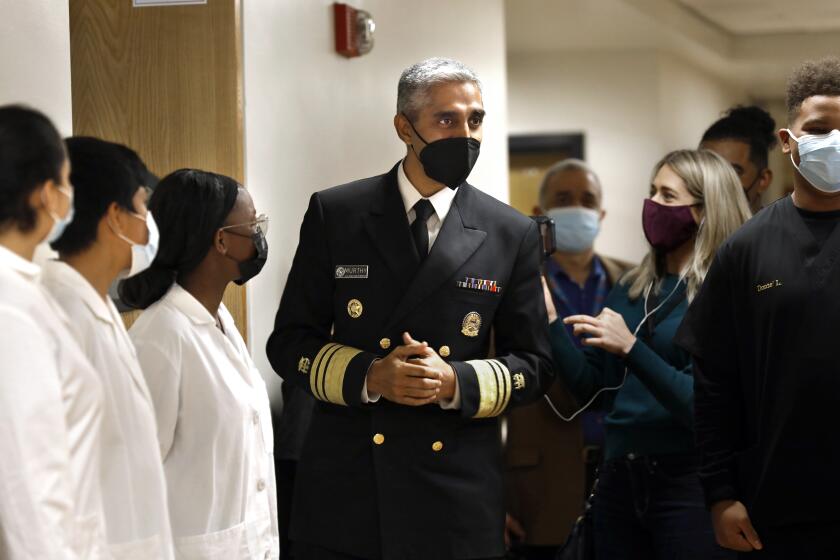Depression was rising among young people in Southern California. COVID made it worse

- Share via
Children, teens and young adults in Southern California had been grappling with rising rates of depression and anxiety for years before the pandemic. Then COVID-19 came along and made their mental health struggles even worse.
Among 1.7 million young patients who were part of the Kaiser Permanente Southern California health system, the prevalence of clinically diagnosed depression was 60% higher in 2021 than it had been five years earlier, according to a new study. The prevalence of anxiety among young patients who did not have depression also rose by 35% during that period, researchers found.
For both conditions, the annual rate of increase was significantly higher during the pandemic years of 2020 and 2021 than in the three years that preceded them.
What’s more, the trend was seen across all demographic groups regardless of age, gender, race, ethnicity or income, according to the report published Tuesday in JAMA Network Open.
“COVID initially was considered an infectious-disease crisis,” said Dr. Siddhartha Kumar, a child and adolescent psychiatrist at Kaiser and the study’s senior author. “This was another side of COVID. The side effects on mental health are long-lasting and impacted the society in a very major way.”
Most U.S. teens aren’t always getting the social and emotional support they need, and most of their parents have no idea, according to a new report.
It’s no secret that young people have been suffering.
In 2016, when the National Survey of Children’s Health asked parents and other caregivers how their youngsters were faring, their responses indicated that 3.1% of kids ages 3 to 17 were depressed. By 2020, that figure was 4%.
That survey also found that the prevalence of anxiety among those children increased from 7.1% to 9.2% during the same period.
Another study of adolescents ages 12 to 17 who participated in the 2021 National Survey on Drug Use and Health found that 20% of them had experienced major depressive disorder in the past year.
And U.S. Surgeon General Vivek Murthy focused the nation’s attention on the issue by issuing a public health advisory about youth mental health in 2021. The advisory cited studies that found 25% of children and teens ages 4 through 17 from around the world had experienced symptoms of depression during the pandemic while 20% had symptoms of anxiety. Both measures had doubled since the start of the pandemic.
The advisory is to call attention to a “youth mental health crisis” and recommend resources to call on and actions to take.
The new study is believed to be the first large-scale examination of youth mental health in the COVID era based on official diagnoses rather than survey data, according to Kumar and his colleagues from Kaiser Permanente Southern California, whose territory extends from Ventura County to the Inland Empire and from Kern County to San Diego.
The study authors focused on the roughly 1.7 million health plan members who were between the ages 5 and 22 on the first day of at least one of the years between 2017 and 2021.
Those children and young adults reflected the diversity of Southern California as a whole, the researchers wrote. About half were Latino, 23% were white, 8% were Asian and 8% were Black. (Data were missing for some plan members.)
Slightly more than half — 55% — were from households with an annual income of $50,000 to $99,999. An additional 29% were from households that earned less, and 16% were from ones that earned more.
The researchers checked whether the young patients had been formally diagnosed with some form of clinical depression. To qualify, a doctor had to determine that a patient was experiencing a “sad or irritable mood or loss of interest in activities” that caused “significant impairment in daily life.”
They found that 1.35% of the patients were newly diagnosed with depression in 2017. That figure rose to 1.58% in 2018, 1.76% in 2019, 1.84% in 2020 and 2.1% in 2021, with the incidence increasing for all groups regardless of age, gender, race, ethnicity or income.
When you’re worried yourself, how can you make your child feel comfortable talking to you about their mental health struggles?
Teens of high school age, 14 to 17, and young adults old enough to be in college, 18 to 22, had the highest incidences of depression throughout the study, the researchers found. Generally speaking, girls and women were more likely to be diagnosed with depression than boys and men, and the risk was consistently higher for patients who were white and who came from households with the highest incomes.
When the researchers tallied all the children and young adults with a new or existing depression diagnosis, they found that the prevalence was 2.55% in 2017, 2.92% in 2018, 3.27% in 2019, 3.53% in 2020 and 4.08% in 2021. The annual rate of increase was higher during the pandemic than before it, and the difference was large enough to be statistically significant, the researchers said.
They also examined patients diagnosed with anxiety, a condition they said was characterized by “excessive feelings of worry or persistent, even intrusive thoughts about certain fears or constant fear in general.”
Nearly 37% of the young patients with anxiety had also been diagnosed with depression. The researchers set them aside and focused on the ones who had anxiety alone.
By that measure, the incidence of newly diagnosed cases was 1.77% in 2017, 2.03% in 2018, 2.1% in 2019, 1.93% in 2020 and 2.32% in 2021.
College-age young adults had the highest incidence of anxiety without depression. The risk was also higher for people who were white and were in the highest income bracket, according to the study.
The prevalence of new or existing anxiety in patients without depression followed a similar pattern — 3.13% in 2017, 3.51% in 2018, 3.75% in2019, 3.61% in 2020 and 4.22% in 2021.
Both new and total cases of anxiety without depression increased significantly more in the COVID years than in the ones preceding it, the researchers found.
“Anxiety, mild depression, hopelessness, disappointment — these are common feelings all of us have from time to time. But it’s another thing when it reaches a clinical level,” Kumar said.
And when that happens to young people, the effects can be enduring.
“The teenage years are when you build your sense of self,” he said. “When adults go through stressful situations in their lives, often their reactions are based on how their sense of self was when they were young.”
It’s been two years since 988 launched to connect Americans to emergency mental health services. The need for it is growing.
A clinical diagnosis is usually considered the “gold standard” for assessing a person’s health, said Michael W. Flores, a behavioral health services researcher at the Harvard-affiliated Cambridge Health Alliance, who was not involved in the study. However, since the Kaiser team focused on members of a single health plan, their findings may not generalize to young people elsewhere, he added.
Christina Bethell, a social epidemiologist and director of the Child and Adolescent Health Measurement Initiative at Johns Hopkins University, said the pandemic had certainly exacerbated the mental health crisis affecting young people nationwide. But she said medical records could not capture the full scope of the problem.
Patients with depression or anxiety may not have access to a doctor, and those who do might not feel comfortable seeking treatment, she said. Primary care doctors are supposed to screen adolescents and adults for depression, but that doesn’t always happen. Even when it does, patients may not answer screening questions honestly. Sometimes doctors make mistakes that lead to misdiagnosis. And sometimes a patient who was correctly diagnosed recovers from depression or anxiety, but their medical records aren’t updated to reflect that.
“Medical records are often wrong, incomplete and only available for those in healthcare,” said Bethell, who wasn’t involved in the study.
In her view, the most important question isn’t whether someone has a diagnosis of depression or anxiety, but how they are actually faring.
“There are a whole bunch of people with a diagnosis who flourish, and there are people without a diagnosis who don’t flourish,” she said. “We want to keep our eye on the prize, which is youth well-being.”











